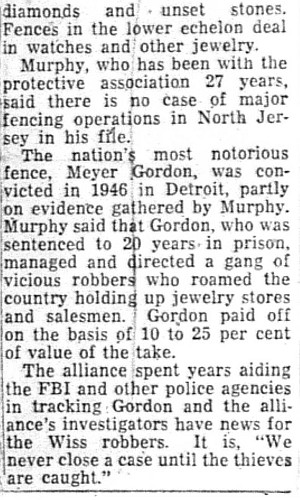



The industry hopes that appearance of the diamonds in the wholesale or retail market will give clews to the identity of the thieves.
The Wiss loot was snatched by three slick gunmen, who walked into the store at 9:30 A.M. a week ago yesterday. The masked thieves dashed across Broad street and were last seen sprinting through Military Park. Private detectives and police assigned to the case said they have turned up no definite clews.
Richard C. Murphy, counsel and chief of the investigating staff of the Jewelers Security Alliance, said: "Sooner or later the Wiss diamonds will show up in the market. When the robbers pulled the job, they were looking ahead to how much dough the ice would bring."
In addition to the thieves, their fence, middleman between the gem robber and the jeweler, is being hunted.
Murphy estimates that the holdup men might net between $15,000 and $16,000 on their $50,000 Wiss loot if they are able to complete a deal with a fence. Men in the business of making a living out of buying and selling stolen goods place a high premium on their services.
Murphy said that one system used by fences to put stolen goods on the market is to send peddlers out to stores and offer items below the prevailing prices. He said, "Some jewelers snatch up the goods, hoping to get a quick profit."
Another method is to sell the hot merchandise to unethical wholesalers.
Murphy said fences operate in all levels of the jewelry industry and that dealing in stolen gems is the sideline of some racketeers and businessmen. One case Murphy cited was a clothing manufacturer who had bought and sold more than $1,000,000 in hot gems before he was arrested and jailed.
Murphy said that most fencing operations are in New York, Philadelphia, Chicago and two or three West Coast cities. He said the big time operators deal only in diamonds and unset stones. Fences in the lower echelon deal in watches and other jewelry.
Murphy, who has been with the protective association 27 years, said there is no case of major fencing operations in North Jersey in his file.
The nation's most notorious fence, Meyer Gordon, was convicted in 1946 in Detroit, partly on evidence gathered by Murphy.
Murphy said that Gordon, who was sentenced to 20 years in prison, managed and directed a gang of vicious robbers who roamed the country holding up jewelry stores and salesmen. Gordon paid off on the basis of 10 to 25 per cent of value of the take.
The alliance spent years aiding the FBI and other police agencies in tracking Gordon and the alliance's investigators have news for the Wiss robbers. It is, "We never close a case until the thieves are caught."